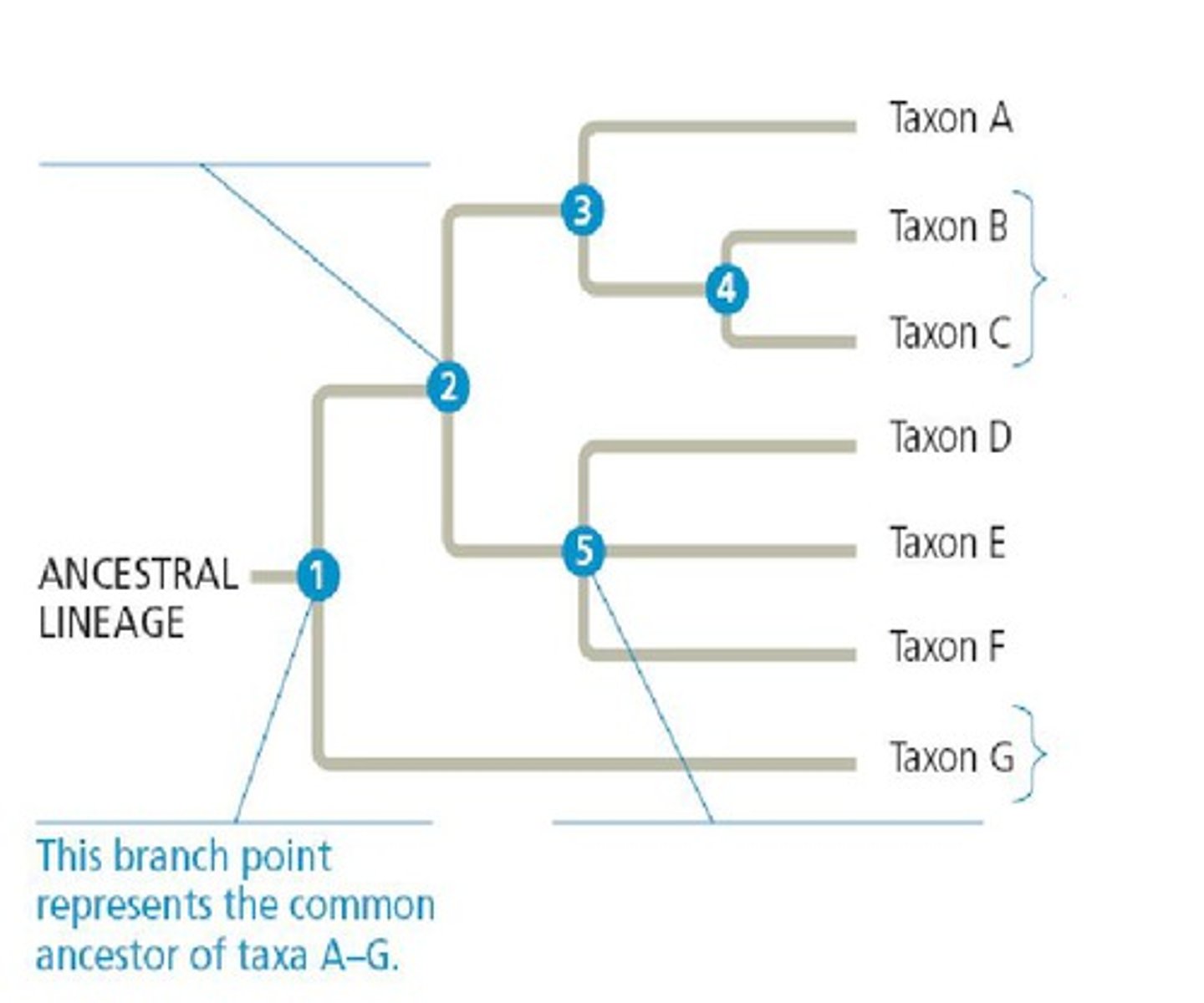Life 103 Exam 1 CSU
1/174
There's no tags or description
Looks like no tags are added yet.
Name | Mastery | Learn | Test | Matching | Spaced |
|---|
No study sessions yet.
175 Terms
Science
recognizing patterns in the natural world and understanding the mechanisms that give rise to those patterns
The Diversity of Life
Patterns
How plants and animals work
Mechanisms
Evolution
the change in allele frequencies in a population over time
Four Mechanisms of Evolution
Selection, Genetic Drift, Mutation, and Migration
Selection
changes in allele frequencies due to organisms with advantageous alleles reproducing more successfully than organisms with other alleles
Genetic Drift
random change in allele frequencies in a population
Mutation
the source of all new allelic diversity
Migration
movement of alleles between population
Adaptation
a trait that evolves by selection for a particular function (because it increases fitness) from an ancestor that did not have that trait; these can be morphological, behavioral, or molecular. They solve problems faced by populations and different populations may have different solutions to similar problems
Phylogeny
the evolutionary relationships of a group of organisms (species level and higher)
Phylogenetic Tree
diagram of the ancestral relationships among species; describes patterns, provides information about when certain large events may occur
Taxonomy
the ordered division and naming of organisms
Carl Linnaeus
published a system of taxonomy based on resemblances; two part name for species and hierarchical classification
Binomial
the two part scientific name of a species
Genus
the first part of the name
Specific Epithet
the second part of the name unique for each species within the genus
Taxonomic groups (from broad to narrow)
Domain, kingdom, phylum, class, order, family genus, species
Taxon
a taxonomic unit at any level of hierarchy
Characters
types of data we can use to reconstruct a tree (morphological traits, behavior, chemical composition, chromosome number, DNA)
Character State
Variation among characters
Branch point
represent the divergence of two species

Sister taxa
groups that share an immediate common ancestor

Rooted tree
includes a branch to represent the last common ancestor of all taxa in the tree
Polytomy
a branch from which more than two groups emerge

Ecology
the study of the distribution and interaction of organisms with other organisms and the environment
Population
a group of individuals of the same species living in the same area
Population ecology
focuses on factors affecting how many individuals of a species live in an area (most mathematically based on sub discipline of ecology)
Community Ecology
deals with the whole array of interacting species in a community
Ecosystem Ecology
emphasizes energy flowing chemical cycling among the various biotic and abiotic components (movement of carbon, nitrogen and other chemicals through the ecosystem)
Biotic Factors
organisms interacting with other species (Predator/prey, Herbivore/plant)
Abiotic Factors
Non-living parts of the environment (chemical i.e. pH/salinity)
Dispersal
the movement of individuals; one way trip (migration is a round trip)
Bacterial cells have a variety of shapes, what are the three most common?
spheres (cocci), rods (boccili), and spirals
Peptidoglycan
a network of sugar polymers cross linked by polypeptides
What do most bacterial cell walls contain?
peptidoglycan
What do both eukaryotes and archaea contain?
Polysaccharides and proteins but lack peptidoglycan
Gram Stain
used to make bacteria visible, classifies many bacterial species (gram positive and gram negative)
Gram Negative Bacteria
have less peptidoglycan, have outer membrane that can be toxic, more likely to be antibiotic resistant
Fimbriae
some prokaryotes have fimbriae (aka attachment pili) which allows them to stick to their substrate or other individuals in a colony
How do most motile bacteria propel themselves and how is this different from eukaryotes?
Via flagella. Structurally and functionally different from eukaryotic flagella, allows for taxis.
Taxis
the ability to move in response to stimuli
What do most bacteria and archaea lack?
Complex compartmentalization; no organelles
Bacteria DNA
most of the genome consists of a circular chromosome
Plasmids
smaller rings of DNA; some species of bacteria have plasmids
What is the typical bacterial genome like?
a ring of DNA that is not surrounded by a membrane
What can bacteria form?
Exospores or endospores
Endospores
internal to the bacterium, resistant to UV radiation, desiccation, alcohol, and chemicals; can survive for extended periods of time
Exospores
formed differently, less robust
How do bacteria reproduce?
Quickly by binary fission, and can divide every 1-3 hours
Bacteria and archaea have considerable genetic variation, what are three factors that contribute to this genetic diversity?
Rapid reproduction, mutation and genetic recombination
How can bacterial DNA from different individuals be brought together?
Transformation, transduction, and conjugation
Transformation
a bacteria can take up an incorporate foreign DNA from the surrounding environment
What are the bacteria that can transform called?
Competent
Transduction
the movement of genes between bacteria by bacteriophages (viruses that can infect bacteria)
Conjugation
the process where genetic material is transferred between bacterial cells
During conjugation what allows cells to connect and pull together for DNA transfer?
Sex Pili
F Factor
a piece of DNA that is required for the production of sex pili; the F factor can exist as a separate plasmid or as DNA within the bacterial chromosome
R plasmids
carry genes for antibiotic resistance; antibiotics select for genes that are resistant to the antibiotics
Phototrophs
obtain energy from light
Chemotrophs
obtain energy from chemicals; black smoker deep vents, major primary producers
Autotrophs
require CO2 as a carbon source
Heterotrophs
require an organic nutrient to make organic compounds; absorb organic molecules or ingest larger food particles
Bacteria metabolism vary how?
With respect to O2
Obligate aerobes
require CO2 for cellular respiration
Obligate anaerobes
are poisoned by O2 and use fermentation or anaerobic respiration
Facultative anaerobes
can survive with or without O2
What happens in nitrogen fixation?
some bacteria convert atmospheric nitrogen (N2) to ammonia (NH3)
Proteobacteria
these gram negative bacteria include photoautotrophs, chemoautotrophs, and heterotrophs; some are anaerobic others are aerobic
Symbiosis
an ecological relationship in which two species live in a close contact: a larger host and a smaller symbiont (Prokaryotes often form symbiotic relationships with larger organisms)
Extremophiles
archaea that live in extreme environments
Extreme halophiles
live in highly saline environments
Extreme thermophiles
thrive in very hot environments
Methanogens
live in swamps and marshes and produce methane as a waste product; they are strict anaerobes and are poisoned by O2
Protista
the informal name of the "kingdom" of mostly unicellular eukaryotes; they constitute a large paraphyletic group and now is longer available as a kingdom
What are protists?
Protists are eukaryotes and thus have organelles and are more complex than bacteria or archaea, most are unicellular but there are some colonial and multicellular species.
Protists, which are the most nutritionally diverse of all eukaryotes, include:
Photoautotrophs, Heterotrophs, and Mixotrophs
Photoautotrophs
contain chloroplasts
Mixotrophs
combine photosynthesis and heterotrophic nutrition
How do protists reproduce?
Both sexually and asexually
Excavata
clade that is characterized by its cytoskeleton; some members have a feeding grove
Diplomonads
have modified mitochondria called mitosomes; are often parites
Parabassalids
have reduced mitochondria called hydrogenosomes; include trichomonad vaginalis, the pathogen that causes yeat infections in human females
Euglenozoa
diverse clade that all have spiral or crystalline rod of unknown function inside their flagella
Kinetoplastids
have a single mitochondrion with an organized mass of DNA called a kinetoplast
Euglenids
have one or two flagella that emerge from a pocket at one end of the cell
Chromalveolata
clade is monophyletic and originated by a secondary endosymbiosis event (w/ red alga), thisclade is controversial and includes the alleviates and the stramenopiles
Superphylum Alveolata
protists have membrane bounded sacs (alveoli) just under the plasma membrane
Phylum Dinoflagllates
diverse group of aquatic mixotrophs and heterotrophs; they are abundant components of both marine and freshwater phytoplankton. Each has a characteristic shape that in many species is reinforced by plates of cellulose
Dinoflagellate blooms
the cause of toxic "red tides", not all red tides are red and not all are harmful
Phylum Apicomplexa
parasites of animals and some cause of serious human diseases
Phylum Stramenopila
Heterokonts
Diatoms
unicellular algae with a unique two part, glass like wall of hydrated silica
Golden Algae
unicellular (some colonial) named for their color, which results from their yellow and brown carotenoids
Brown algae
largest and most complex algae; all are multicellular, and most are marine. Include many species commonly called "seaweeds"
The rootlike _____ actors the stemlike _____ which in turn supports the leaflike ______
holdfast; stipe; blades
Alternation of Generations
the most complex life cycles, the alternation of multicellular haploid and diploid forms
heteromorphic
generations are structurally different
Isomorphic
generations look similiar
Rhizaria
DNA evidence supports rhizaria as a monophyletic clade